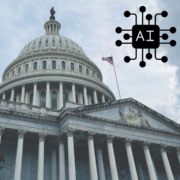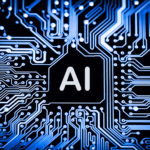The Main Reason There Will not be an AI-centric Contract Vehicle in the Federal IT Services Space
Federal IT Vendors Navigating AI Hype
Since OpenAI’s ChatGPT garnered mainstream attention and media coverage at the start of 2023, it feels like every federal IT services vendor has been spurred on to disclose what they are doing with AI out of fear of being left behind by their competitors.
While Booz Allen Hamilton (NYSE: BAH) and Leidos (NYSE: LDOS) were innovators that were actively investing in early state generative AI (GenAI) prior to the pandemic, plenty of other vendors in the federal IT space have become increasingly active in regard to discussing their AI-related activities and how the technology will factor into their respective go-to-market strategies.
For example, General Dynamics Information Technology (GDIT) (NYSE: GD) touts AI for IT operations and AI for mission applications as two of its core digital accelerators. ManTech recently unveiled its own Data Analytics and Artificial Intelligence Solutions Practice, and Maximus (NYSE: MMS) has also been getting involved.
While Maximus had been signaling that it viewed AI as a strategic growth opportunity since earning its seat on the Department of Defense’s (DOD) Joint AI Center Data Readiness for AI Development program in 2022, the company’s AI-related announcements ramped up in 2023. Maximus brought on Kathleen Featheringham as its VP of AI Consulting Services for U.S. Federal Services in March after she played a prominent role in establishing Booz Allen Hamilton’s strategy to further penetrate the U.S. federal IT sector by utilizing AI. Additionally, Maximus became talkative about how it was experimenting with AI internally.
AI is an opportunity for Maximus to augment its customer service representatives, easing their workloads while enhancing the customer experience. The company wants to train its new hires in scenarios with AI to speed up their development process and ensure they are capable of assisting clients. Booz Allen Hamilton is doing something similar with its workforce through its new alliance with Workera. One of Maximus’ long-term goals, though, is to train AI on historical data to the point that it can analyze an agent’s ongoing conversation with a client and provide potential remedies.
The Likelihood of an AI-centric Contract in Federal IT
As vendors of all shapes and sizes continue accelerating their efforts to harness AI, many analysts and market watchers are asking: When will we see a government agency award a vendor a revolutionary AI-centric contract? According to TBR’s research, in all likelihood, we will not.
While GDIT’s “Seeds of Change” study published in 3Q23 showed that 28% of government agency respondents either had AI solutions in use or anticipated that they would be in use within the next year, it is not so simple to have a massive contract vehicle focused solely on AI. The main reason for this is that many government agencies still need to address their aging IT systems. Far too many federal IT infrastructures are still running on monolithic mainframe systems and have archaic software and out-of-date programming languages. As my colleague, John Caucis, frequently quips to clients: “They can’t put AI on COBOL.”
Federal IT spending has been accelerating at a rapid rate over the last few years to support agencies undertaking their digital modernization journeys. To capitalize on this surge in available funding, vendors have been leveraging their partner networks to show agencies how they can help clients complete a litany of tasks like setting up hybrid cloud environments, improving their cybersecurity and introducing data analysis tools.
Some vendors, like Peraton, have been positioning themselves as cloud services brokers as government agencies look to customize their own cloud platforms with third-party services. As one might expect, demand for these services will steadily expand as agencies increasingly look at incorporating AI-powered tools into their environments.
Before these agencies can begin utilizing these tools, though, they first need to gather their data and then understand it. This is where vendors like ManTech are stepping in. ManTech’s consultants are helping agencies identify where they are in their digital transformation journey. From there, ManTech works with the client on planning, designing and delivering solutions that allow these agencies to reap the benefits of the technology. As more agencies name their chief AI officers and outline their AI strategies, there will be plenty of opportunities for vendors to get involved.
How Federal IT Vendors Will Find Success in AI
Vendors will need to onboard AI experts while also upskilling employees and ensuring they can utilize the technology in a responsible manner. For example, SAIC (Nasdaq: SAIC) is showing a willingness to take a margin hit and deploy its free cash flow to internal programs to cross-train and upskill its entire workforce on AI during 2024.
As vendors seek to capitalize on the growing demand for AI services, their relationships with technology giants like Amazon Web Services (Nasdaq: AMZN), Google (Nasdaq: GOOG) and Microsoft (Nasdaq: MSFT) will also become increasingly crucial. Successful vendors need to deepen their partnerships and demonstrate how their technologies can augment the hyperscaler platforms that agencies use. Having access to these giants lends vendors credibility while giving them access to the robust technologies and insight into how those technologies are being best used in the commercial space.
Additionally, vendors hoping to capitalize on AI solutions will need tangible use cases — for example, offering a customer-zero approach where vendors can show instances of how the technology has been applied internally. Rather than buying into the hype around AI, clients will want to see how the technology has been successfully and responsibly applied and know that they are not the testing ground.
For example, before making CGI PulseAI publicly available, the platform was developed for CGI’s (NYSE: GIB) own internal use. As stated in a March 2024 TBR special report, “[Global AI Enablement VP Diane] Gutiw described CGI’s take on this idea, noting that the company innovates, develops and tests GenAI-enabled solutions internally, like other vendors, but ensures clients understand that CGI views this investment as a way to save clients’ money: ‘We always talk about fail fast. We’re doing that on our dime because we would not fail fast on your dime.’”
Conclusion
AI obviously offers ways for various agencies to improve their productivity in the short term. It presents a chance for healthcare agencies to not only gather their data but also better understand it and meaningfully utilize it. However, this will require more than just an AI-centric contract vehicle.
For example, as discussed in a 2022 TBR special report, the DOD’s vision for Combined Joint All-Domain Command and Control (CJADC2) is to create “a cloudlike environment that enables the rapid receipt and transmission of intelligence, surveillance and reconnaissance (ISR) data to interconnected networks. By developing a unified network that enables sensors on Internet of Military Things (IoMT) devices to instantly pass on mission-critical information to leaders, more informed and coordinated decision making is possible across the U.S. military’s branches. Decision makers can act faster and establish more cohesive battlefield tactics, factoring in land, sea and air threats with additional support from each other’s assets due to this common operating picture (COP).”
AI would play a prominent role in enabling the DOD’s CJADC2 vision — from immediately relaying this COP to even tagging threats and suggesting the optimal weapon to be used given the situation. Yet to even get to that point, the U.S. military branches would need to invest in an antifragile cloud environment underpinned by 5G technology and have robust cybersecurity measures in place.
AI will eventually be a valuable tool for agencies, but it will not be delivered to them through a single AI-centric contract vehicle.

 Technology Business Research, Inc.
Technology Business Research, Inc.
 Getty Images via Canva Pro
Getty Images via Canva Pro